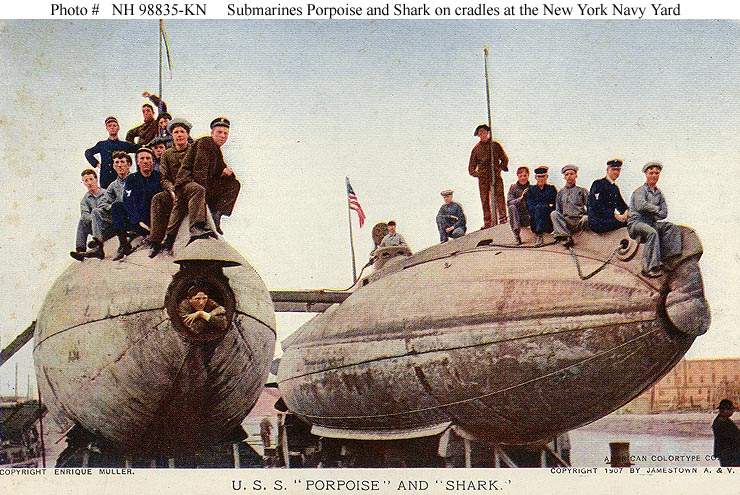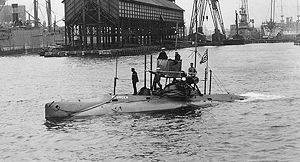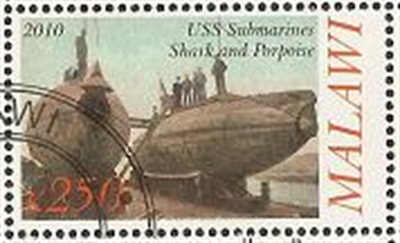|
USS Porpoise, SS-7 & USS Shark, SS-8
 USS Porpoise, A-6/ SS-7 USS Porpoise, A-6/ SS-7The submarine torpedo boat A-6, Plunger class, was originally laid down as Porpoise (Submarine Torpedo Boat No. 7) on 13 December 1900 at Elizabethport, N.J., by the Crescent Shipyard of Lewis Nixon, a subcontractor for the John P. Holland Torpedo Boat Co. ofNew York, launched on 23 September 1901, and commissioned at the Holland yard at New Suffolk, N.Y., on 19 September 1903, Lt. Charles P. Nelson in command.
Assigned initially to the Naval Torpedo Station at Newport for experimental torpedo firing work, Porpoise entered the New York Navy Yard in September 1904 for repairs and alterations, remaining there until February 1906. Assigned then to the First Torpedo Flotilla on 7 March 1907, the submarine torpedo boat operated at Annapolis, Md., temporarily assigned to the Naval Academy for instruction of future naval officers, until June 1907. Taken subsequently to the New York Navy Yard, she was decommissio ned on 21 April 1908. Partially disassembled, she was then loaded on the after well deck of the collier Caesar for a voyage to the Philippine Islands as deck cargo along with her sister ship Shark(Submarine Torpedo Boat No. 8), via the Suez Canal.
Arriving at the Naval Station at Cavite, Porpoise was launched on 8 July 1908 and recommissioned on 20 November.
In April 1909, Ens. Kenneth Whiting, a future naval aviation pioneer, became Porpoise`s commanding officer. On 15 April, Whiting and his crew of six took the submarine out for what was to be a routine run. Porpoise got underway, cleared the dock and moved out into Manila Bay. She dove soon thereafter, and leveled off at a depth of 20 feet. Only then did Whiting, with contagious confidence, reveal his intentions.
Convinced that a man could escape from a submarine through the torpedo tube, Whiting determined that he was going to try and test his theory with himself as a guinea pig. Squeezing into the 18-inch diameter tube, he clung to the crossbar which stiffened t he outer torpedo tube door, as the crew closed the inner door. When the outer door was opened and water rushed in Whiting hung onto the crossbar that drew his elbows out of the tube`s mouth, and then muscled his way out using his hands and arms, the entir e evolution consuming 77 seconds. He then swam to the surface, Porpoise surfacing soon thereafter. Reticent to speak about the incident in public, he nevertheless informed his flotilla commander, Lt. Guy W. S. Castle, who submitted a report on how the feat had been accomplished. In Porpoise`s log that day, Whiting had simply commented: "Whiting went through the torpedo tube, boat lying in (the) water in (a) normal condition, as an experiment ...."
Subsequently becoming a unit of the First Submarine Division Asiatic Torpedo Fleet, on 9 December 1909, the submarine torpedo boat continued her routine of local operations out of Cavite for the next decade. Renamed A-6 (Submarine Torpedo Boat No. 7) on 17 November 1911 she patrolled the entrance to Manila Bay and convoyed vessels out of port during World War I under the command of Lt. A. H. Bailey.
Placed in ordinary on 1 December 1918, until decommissioned on 12 December 1919 and turned over to the Commandant of the Naval Station at Cavite, for disposal. Given the alphanumeric hull number SS-7 on 17 July 1920, A-6 was authorized for use as a target in July 1921 and as of 16 January 1922 was struck from the Naval Vessel Register.
 USS Shark, A-7/SS-8 USS Shark, A-7/SS-8The submarine torpedo boat A-7, Plunger class, was originally laid down as Shark (Submarine Torpedo Boat No. 8) on 11 January 1901 at Elizabethport, N.J., by the Crescent Shipyard of Lewis Nixon, a subcontractor for the John P. Holland Torpedo Boat Co. of New York; launched on 19 October 1901; Built with a hull of manganese bronze, Shark was equipped and outfitted at the Holland yard at New Suffolk, N.Y., and was commissioned there on 19 September 1903, Lt. Charles P. Nelson in command.
Over the next three and a half years, Shark operated locally at the Naval Torpedo Station at Newport, conducting firing tests with torpedoes, and participating in early research and development efforts in the field of undersea warfare. Assigned to the First Submarine Flotilla in March 1907, Shark was stationed at the Naval Academy at Annapolis, Md. in the spring of 1907.
Taken to the New York Navy Yard in April 1908, the submarine torpedo boat was decommissioned there on the 21st of that month. Loaded on board the collier, Caesar,Shark and her sistership, Porpoise( Submarine Torpedo Boat No. 7), comprised the auxiliary`s deck cargo as she proceeded, via Suez, for the Philippine Islands. Sharkwas launched soon after her arrival at Cavite in July and was recommissioned on 14 August 1908.
Over the next several years, the submarine torpedo boat operated out of Cavite, interspersing training with periodic upkeep and repair work. On 17 November 1911, Shark was renamed A-7.
During World War I, A-7 and her sisterships based at Cavite and carried out patrols of the entrance to Manila Bay. In the early spring of 1917, Lt. (j.g.) Arnold Marcus assumed command of A-7. On 24 July 1917, shortly after the submarine torpedo boat`s engine had been overhauled, gasoline fumes ignited and caused an explosion and fire while in the course of a patrol in Manila Bay.
After Marcus and his men had battled the blaze, he ordered the crew topside and into the boats that had been summoned alongside. The last man to emerge from the interior of the crippled submersible, Marcus sent up distress signals to the nearby monitor Monadnock and then took the helm himself in an attempt to beach the ship. He refused medical treatment until all his men had been attended to (six later died) and had to be ordered to leave his post. The gallant Marcus died the next day 25 July 1917, of the effects of the explosion and fire that had ravaged his command. The Navy recognized this young officer`s selfless heroism in naming a ship, Marcus (Destroyer No. 321), in his honor.
Placed in ordinary at Cavite on 1 April 1918, A-7 was decommissioned as of 12 December 1919. Given the alphanumeric hull number SS-8 on 17 July 1920, A-7-initially advertised for sale in the 16th Naval District-was subsequently authorized for use as a target in 1921. She was struck from the Naval Vessel Register on 16 January 1922.
Back to History Index
 |
Malawi |
2010 |
US submarines Shark & Porpoise (Plunger class, Porpoise SS-7, Shark SS-8, 1903) |
|